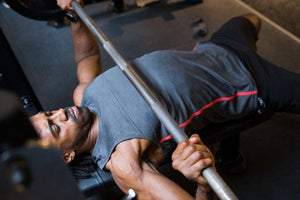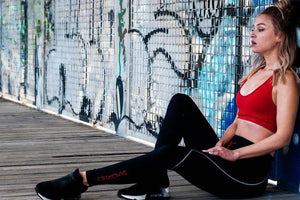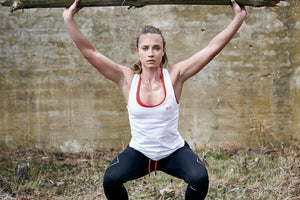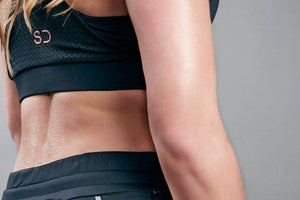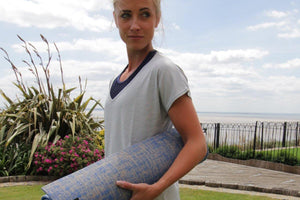There is lots of bad advice out there on how to squat (or how not to squat!) We look at 4 of the biggest squat myths to ignore and why.
1. Your knees can never go over your toes when you squat
The theory that knees should never go over toes was found in a study that found maintaining a vertical lower leg as much as possible reduced strain on the knee during a squat. However, the study only looked at two dimensional models of the knee joint, so it lacked consideration of forces working from above, at the hip, below, and at the ankle, which all receive considerable force in this position
Further research by Smith and Fry in 2003 compared unrestricted squats, where the knee could travel freely over the toe, to squats where a vertical board was placed over the lifters shins and physically prevented the knee moving over the toe. Whilst forces on the knee were reduced by 22% due to the restricted range of movement, forces were increased by 1000% on the knee joint.
The reason we are told to ensure our knees don't go over our toes is actually less about our toes and more about our centre of gravity and muscle recruitment. With the weight shifted back, we get more muscle activation from the glutes and hamstrings, whereas when our weight is shifted forward the focus is more on the quads and anterior chain. So… knees over toes is a myth as the toes simply serve as an arbitrary point and the guideline should really be more to do with how to balance load, but the knees over toes works as a simplified guideline.
2. Deep squats are bad for your knees
Look at how a child squats, in fact most children will spend the majority of their time in what looks like a deep squat. That’s a big hint that it’s not bad for you, as a child will not put themselves in a position that causes them pain, they move in our natural movement patterns until they are taught otherwise.
What then happens is our kids grow up and we start introducing the pattern of sitting behind a desk all day. That’s 7-8 hours of sitting and what that does to our flexibility is where the issues arise.
Contrary to popular belief, squatting deep is not bad for the knees - studies have found there is no difference between partial, parallel and deep squats impact on the knee. In the study by Clinical Biomechanics, five female athletes were studied throughout squats with varying degrees of flexion at the knee and concluded that squatting from 70 degrees to 110 degrees of knee flexion had little effect on patellofemoral joint kinetics.
Another study by The Journal of Biomechanics found that the deeper the squat, the less pressure is created inside the knee. The journal of strength and conditioning research also completed a study which concluded that parallel squats with heavy weights are less effective at increasing strength than deep squats with a lighter weight.
Obviously, there is not a one-size-fits-all perfect squat, but in most cases, gradual progressive training to the full range of motion of a deep squat will be effective.

3. If it doesn’t break parallel it doesn’t count
Myth. Despite the research supporting squat depth as seen above, failing to squat deep doesn’t mean that the squats don’t count. In fact squatting to parallel is probably the most widely used squat because it is arguably the safest form of squatting and the easiest to perform.
For some people, though it has greater muscle activation, squatting below parallel just isn’t possible, be it due to lack of flexibility, lack of strength or lower back issues.
If the lower back rounds when the athlete performing a full squat breaks parallel, it's time to stop. Rounding of the back during this phase of the squat places intense pressure on the lower vertebrae of the back. Research has shown that during the deepest phase of the squat, this compression is six times greater than at the top of a squat.
As your spine flattens out with a heavy barbell across your shoulders, a large amount of pressure is imposed on the discs in your spine. Eventually, if your form isn’t spot on this can lead to tissue damage and back pain. Repeatedly sliding out of a neutral spine position increases your risk of serious injury and a hunched back. All of which can be avoided by squatting to parallel, or even breaking parallel but rising before your bum tucks.
Work on flexibility by performing bodyweight squats and gradually sinking lower until you can break parallel and enter the full squat without compromising your spine. Dynamic warm ups and flexibility work will help to increase your range of motion.
4. Look up as you squat
As much as you may enjoy staring at your squirming face as you squat, “head up” is one of the worst commands you can give to a client. The logic behind it was/is that the body goes where the head leads and therefore if you look up, you will be less likely to fail your squat. However, with a heavy load across your shoulders looking up increases the amount of pressure on your neck and could potentially lead to slipping the discs in your neck. Ideally, the aim should be to keep your spine in neutral alignment. For most people you need to keep your eyes forward and tuck the chin slightly.
Now you’ve sorted fact from fiction, why not check out our page on Squats.



